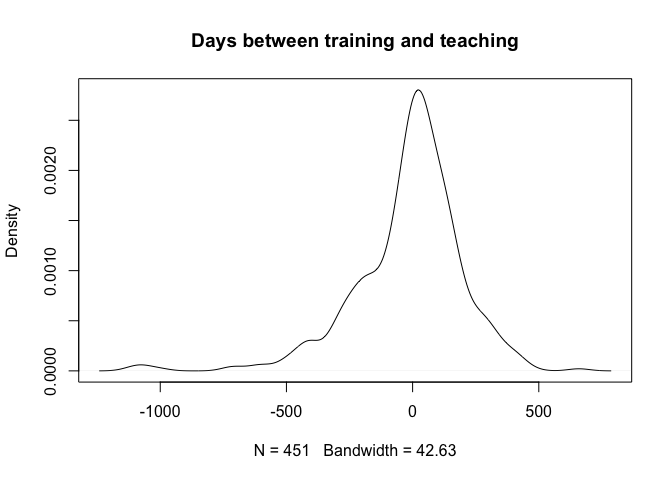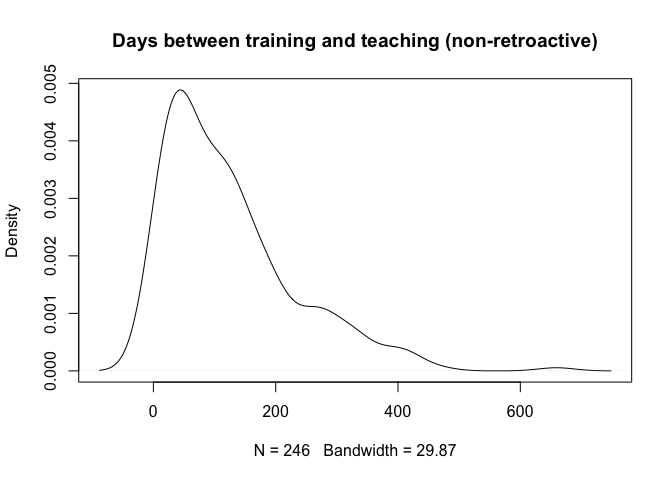Instructor and trainee involvement
This post originally appeared on the Data Carpentry website
This analysis is meant to answer questions about the extent of the non-teaching instructor and the non-certified trainee issues.
Analysis and Data Files
The RMarkdown that generated this document: Completion_rates.Rmd
The data: In the Data Carpentry metrics repo
the files
instructor_data_5_17_16_no_ids.csv
and
trainee_data_5_18_16_no_ids.csv
Questions
Questions to be answered include:
What percent of fully certified instructors haven’t taught?
- Overall
- Only those > 1 year past training
What percent of one-time instructors have only taught at their home institution?
What percent of trainees haven’t finished checkout within 90 days of training?
- Including online trainees
- Excluding online trainees
Data was collected from AMY database (instructor completion) and Google
sheet (trainee completion) by Greg Wilson on 5/17/16.
Note: This data can not answer Question #2.
Definitions:
Trainee - person who has gone through instructor training but may not
have completed checkout.
Instructor - person who has gone through both instructor training and
checkout.
Trainee completion rate
Looking only at training sessions from at least 90 days ago:
- overall completion 54.73%
- in person completion 56.21%
- online completion 51.35%. (Two events, 63% and 31%).
Most (10/14) in person events have >65% completion rate. Some (Arlington, OK, Melbourne, Florida) much lower.
Takeaway: Overall, online sessions didn’t have a noticably lower completion rate than in-person sessions, but this appears to be due to a few in-person sessions have very low completion rates.
Some other events do not look on track to meeting normal completion rates (e.g. UCDavis - 84 days, 39%; UW - 68 days, 14%). More follow-up with these participants likely needed.
Wonder whether these abnormal rates are due to issues with local community, issues with how training session went, or some other factor.
Summary of completion rates per event:
## Min. 1st Qu. Median Mean 3rd Qu. Max.
## 22.22 38.00 70.72 66.73 89.28 100.00
Note that mean completion rate for individual events is not the same as mean overall completion rate, as the number of participants per event varies.
Instructor teaching rate
What percent of instructors trained over a year ago haven’t yet
taught?
Trained over one year ago: 378
Of which, haven’t taught: 70
This is 18.52%.
What percent of total instructors haven’t taught?
Total trained: 673
Haven’t taught: 222
This is 32.99%.
What percent of instructors trained within the past year haven’t yet
taught?
Trained within last year: 295
Of which, haven’t taught: 152
This is 51.53%. (But many of these may have been trained very
recently.)
What percent of instructors teach within their first year?
Took longer than one year to teach: 10
Haven’t taught (been over a year since training): 70
Total percent who didn’t teach within first year: 15.36%
What is the distribution of time to first teaching?

Note that many (204) instructors taught their first workshop before they were officially certified.
Excluding them:
Summary of time to teach first workshop (non-retroactive):
## Min. 1st Qu. Median Mean 3rd Qu. Max.
## 1.0 42.0 98.0 124.6 175.8 659.0
Are recently trained instructors on track to meet normal teaching
rates?
Overall, half of instructors teach w/in 98 days.
Trained between 95-120 days ago: 71
Of which, haven’t taught: 33
This is 46.48%.
Recent batch of trainees appear to be on track.
Conclusions redirect_from: /blog/instructor-metrics/
Online training sessions do not appear to have lower completion rates than in-person sessions. Completion rates are quite variable between training sessions. This may indicate greater follow-up needed. Overall completion rates ~55%.
Most instructors (~85%) teach within their first year. About half teach within 100 days. Current group of trainees is on track to meet that target.